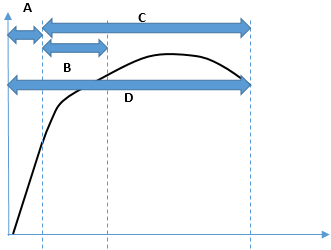This set of Mechanical Metallurgy Multiple Choice Questions & Answers (MCQs) focuses on “Metal Working Fundamentals – Hydrostatic Pressure”.
1. In the metalworking process, the stress, in the range as shown by engineering stress-strain curve is _______

a) A
b) B
c) C
d) D
View Answer
Explanation: In metalworking, the metal is deformed plastically, so the range of stress in which it is carried is above the elastic limit but below the fracture stress of the material. In the curve, it is shown by region C.
2. Which of the following event does not occur in the hot working of the metal?
a) Recrystallization
b) Recovery
c) Grain refinement
d) Twinning
View Answer
Explanation: The twinning is low-temperature phenomena primarily associated with the hexagonal closed packed materials. So the twinning does not occur in hot working.
3. The improvement in the strength of the material is much more in hot working compared to cold working.
a) True
b) False
View Answer
Explanation: The strength of the material increases because of the entanglement of the dislocation, so the plastic deformation is restricted. The generation of the dislocation is much more in cold working than in hot working.
4. Which of the following statement about cold working is not true?
a) Surface finish improves
b) Mechanical strength increases
c) Grain size remains the same
d) Number of dislocations increases
View Answer
Explanation: During the cold working, the grain size of the material generally reduces. Because of dislocation produced, the cell structure is formed which causes the refinement of grain size.
5. Which of the following metal working process produces the preferred orientation of grain in the workpiece?
a) Forging
b) Rolling
c) Piercing
d) Sheet metal forming
View Answer
Explanation: The rolling produces the preferred orientation of grains along the rolling direction. Because the material is elongated along a specific route, so the grain is also extended in the same direction and it is called the texture.
6. The tumbling is the process of _____________
a) increasing the diameter of the parts
b) decreasing the diameter of the parts
c) cleaning the surface of the workpiece
d) providing the protective coating to the surface
View Answer
Explanation: The tumbling is the process to clean the surface of the workpiece before carrying out the metalworking process. It reduces the required energy of working.
7. The steel balls for ball bearing is produced by which of the following method?
a) Casting
b) Rolling
c) Spinning
d) Cold heading
View Answer
Explanation: The steel balls for ball bearing are made from long steel wire which is cut into small piece, and then these pieces are shaped into sphere by cold heading and other short processes.
8. In which of the following cutting process, the abrasive slurry is used as a medium of cutting?
a) Electro discharge
b) Plasma arc cutting
c) Ultrasonic cutting
d) Laser cutting
View Answer
Explanation: The abrasive slurry is made to fall at very high speed in a very narrow area to cause the localized impact of cutting in the sheet metal. It does not use electricity for it.
9. In the electro-discharge machining operation, the section thickness should be low to work efficiently.
a) True
b) False
View Answer
Explanation: The electro-discharge machining produces an excellent surface finish, and the sample should be thin in size for the process to work efficiently.
10. The binding material for carbide-based tools is _________
a) iron
b) cobalt
c) lead
d) zinc
View Answer
Explanation: In carbide-based tools, the hard carbide phase particles are submerged in soft cobalt matrix which acts as supporting material. Such tools are used for cutting tough materials.
11. The cemented carbide tools wear the most at ___________
a) high speed
b) low speed
c) intermediate speed
d) discontinuous change of speed
View Answer
Explanation: The wearing out of the carbide particle is maximum when the speed of the tool or the wheel is low compared to the high speed.
Sanfoundry Global Education & Learning Series – Mechanical Metallurgy.
To practice all areas of Mechanical Metallurgy, here is complete set of 1000+ Multiple Choice Questions and Answers.
If you find a mistake in question / option / answer, kindly take a screenshot and email to [email protected]
- Check Metallurgical Engineering Books
- Apply for Metallurgical Engineering Internship
- Check Mechanical Metallurgy Books
- Practice Metallurgical Engineering MCQs
